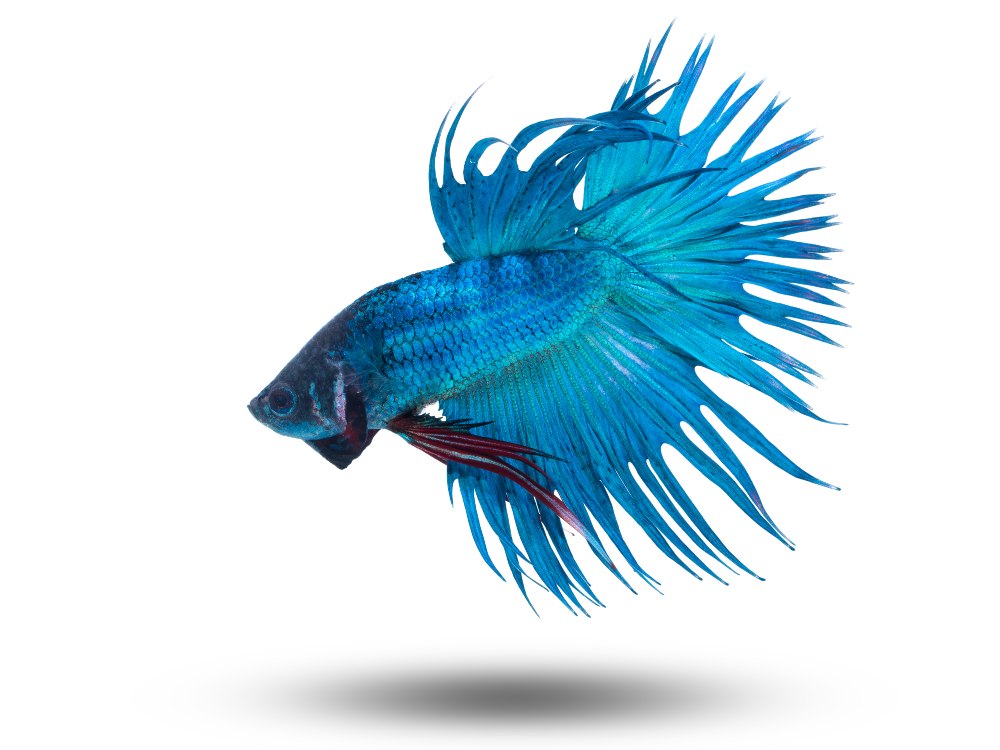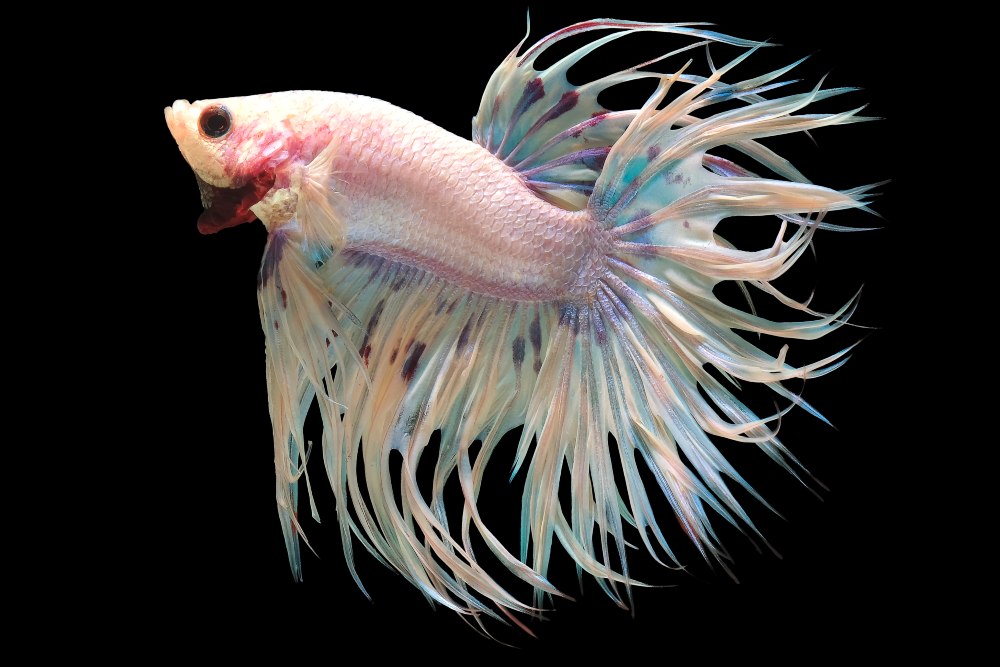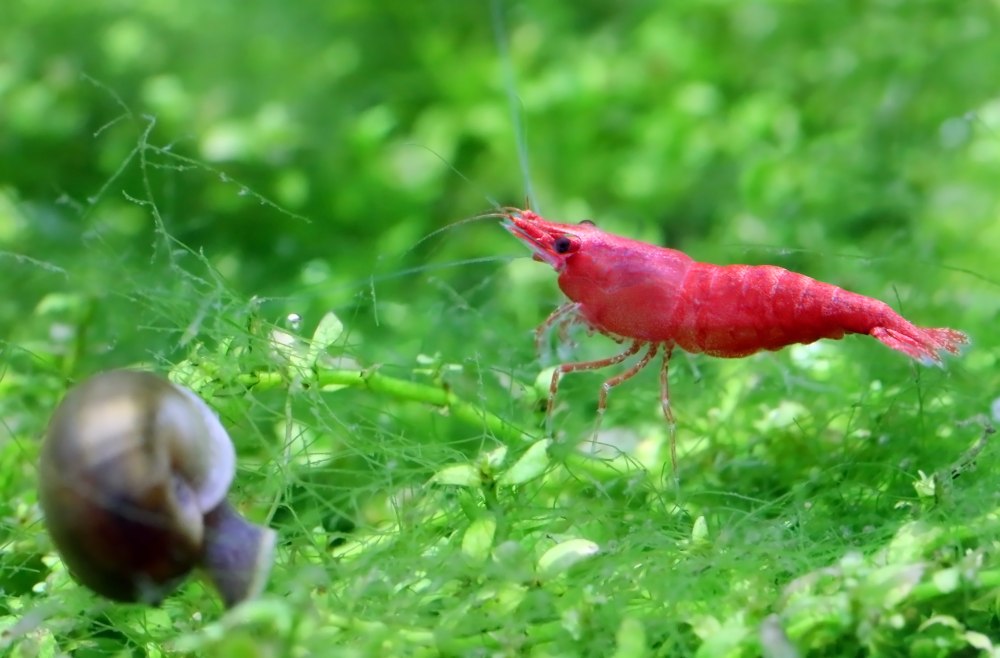There are almost seventy-three species of betta fish, and the crowntail betta is one of the popular ones. Crowntail bettas are native to Southeast Asia and is mainly found in regions like Thailand, Vietnam, Cambodia, Myanmar, and Malaysia.
Crowntail betta, also known as the Siamese fighting fish in the B. Splendens family, is a great fish when taken care of properly.
Crowntail betta fishes don’t require too much care and are easy to keep, however, they are very particular about their living conditions, and things like their aquarium size, water parameters, and tank set up must be just right otherwise they will fall ill.
Today, we’re discussing everything you need to know to keep a crowntail betta!
| Crowntail betta overview | |
| Lifespan | 2 to 3 years |
| Temperament | Very aggressive |
| Fin and tail shape | Spiky, webbed, flowing fins and tail |
Crowntail betta fish: identification and temperament

Betta splendens, or crowntail bettas, are a tropical fish found in the freshwaters of Southeast Asia.
Like other betta species, these are colorful fish with gorgeous fins.
But what sets crowntail bettas apart is their beautiful caudal fins and anal fins, which they can stretch up to three times longer than their bodies.
Crowntail bettas grow bigger than other betta varieties and have long and slender bodies. They have long flowing fins with webbed edges, but they only flare them out when fighting or trying to intimidate others.
They have a unique mouth shape that is hinged and upturned, known as supra-terminal mouths. Crowntail bettas can be found in different colors like vibrant red, white, black, purple, neon blue crowntail betta, bright orange, green, and other metallic colors.
Crowntail betta fish grows up to 2.5 inches to 3 inches long, and the average crowntail betta lifespan is two to three years.
Male crowntail bettas and female crowntail bettas have distinct features you can use to tell them apart.
Male crowntail bettas have an opercular membrane under their gill plate cover. The membrane becomes more visible when the fish gets aggressive, but you can still see it when the fish is relaxing.
Female betta fish are smaller than the male crowntail betta fish. They also have significantly smaller fins, and their body color isn’t as vibrant as the male bettas.
Talking about temperament, these Siamese fighting fish have an aggressive nature like all other betta species. You should never house two male betta fish in the same tank as they get extremely violent, and they’ll likely fight to the death.
Crowntail betta care: tank size, water parameters, tank setup, and diet

All betta species are very particular about their living conditions. They need the same environment as their natural habitat to survive in the tank, otherwise, they’ll fall ill and get stressed.
Tank size
Crowntail bettas need a spacious tank, and the minimum tank size for keeping one crowntail betta is at least five gallons, but a ten gallon tank is even better. Don’t make the mistake of keeping them in a vase or fishbowl, as it will suffocate and stress out the betta.
These fish are used to living in flowy water streams and they can’t adjust to a small tank. Also, crowntail bettas love to explore the tank, and they simply can’t explore in a small vase.
The five gallon recommendation is for a single betta, however, if you keep your crowntail betta in a community tank, you have to get an even bigger aquarium. Bettas need their own space and if they come in contact with their tank mates frequently, they’re more likely to get spar.
Tank set up
To keep the crowntail betta happy, you must recreate their natural habitat. The slow, flowy streams of Southeast Asia are full of vegetation, and other organic materials. Therefore, add enough live plants like Indian almond leaves, floating plants, java fern, java moss, and other aquatic plants in the fish tank to keep your betta happy.
Do not add plastic plats with sharp edges. These can damage the delicate caudal fins of the crowntail betta. The same goes for substrates: avoid anything with sharp edges as these too can injure their fins.
Keeping enough plants is necessary because these Siamese fighting fish need plenty of hiding places. Also, don’t use a very bright light in the aquarium since betta fish prefers a dimly lit tank environment.
Water parameters
The right water parameters are crucial if you want your crowntail betta fish to survive longer. Bettas are affected by the water changes and are sensitive to their environments.
When it comes to water temperature, crowntail betta fish need warmer water temperatures between 75 to 80 degrees Fahrenheit. If the tank water gets too warm or too cold, it will stress out the fish leading to different diseases.
Crowntail betta fish also can’t adjust to acidic waters, so maintain the pH level between 6.8 to 7 at all times. The water hardness levels for betta fish should be between 3 to 5 dKH (Degrees of Carbon Hardness).
You also need to change your tank water weekly. All betta fish species, including crowntail bettas, are extremely susceptible to infections, and crowntail betta fin rot is one of the common signs of excessive toxin build up in the aquarium water. If you have a water filter, change 20% of the water with each weekly cleaning. If no filter, change 30% to 50% of the water. We recommend doing full tank cleans every 6-8 months.
Lastly, as crowntail bettas are labyrinth fish (they take oxygen from both water and air), you must leave room at the top of your tank for the betta to come up and breath. Do not fill your tank to the brim, and because betta fish are excellent jumpers, you should have a cover on the top of your tank.
Diet
Crowntail betta fishes are carnivorous fish, so fish keepers must provide them with a protein rich diet. Some of the healthy food to feed your betta fish are mosquito larvae, insect larvae, betta pellets, frozen foods like blackworms, brine shrimp, blood worms, and white worms.
For healthy growth, you should include a variety of food and not restrict their diet to just one type.
Bettas have a very small stomach so beware of overfeeding them. Ideally, you should feed the crowntail betta fish two times a day, and their feeding time should last for roughly two minutes. Make sure to remove any uneaten food from the tank, as the fish will eat them even if they have a full stomach.
Overeating is extremely dangerous for the betta fish. It affects the nitrogen cycle leading to constipation which can ultimately kill the crowntail betta. A couple of common sighs of an overfed crowntail betta are eyes popping out of their head, a swollen body, and a lethargic fish.
Common diseases
These freshwater fish can easily catch diseases if you don’t pay enough attention to their tank conditions and eating habits. Here are some of the diseases your betta fish may show in inadequate living conditions.
Bacterial infections
Bacterial infections are common if you don’t clean the tank properly. The aquarium plants can also cause fungal infections, which affect the body and fish skin. One of the usual signs of bacterial infection is fin rot.
Ich
Ich is another common disease in all freshwater fish. You’ll notice tiny white spots in the betta body when it gets the disease and the betta rubbing its body against aquarium walls or tank substrates.
Overeating
As mentioned earlier, bettas need very controlled portions of food. Overeating can lead to diseases like constipation, swollen body, and bulging eyes.
Tank mates

Due to their fighting temperament, you have to be wise while picking tank mates for your crowntail betta. A crowntail betta’s aggressive nature does not make it suitable for community tanks, but there are some peaceful fish that can live with these fish.
But first, never keep two male fish in the same tank. Males are simply too aggressive to house in the same tank. You may be able to keep one male and one female together, but we only recommend this for experience aquarists who are planning to mate the two. On the other hand, keeping multiple female crowntail bettas in the same tank is doable, but again, we only recommend this for experience aquarists.
While keeping other fish, you have to consider factors like tank size, food habits of both the species, and tank requirements of the other fish. You should only go for those fish species which share the same tank requirement as the crowntail betta.
Different living conditions will make either of the fish suffer, ultimately leading to their death. Here are some of the other fish species that make suitable crowntail betta tank mates:
- Corydoras catfish
- Shrimp species like ghost shrimp, cherry shrimp, and Amano shrimp
- African dwarf frogs
- Snails
- Neon tetras
All these species require almost the same tank condition as the betta fish, so keeping them together is easy. Plus, all these are bottom dwellers, so there are fewer chances of the crowntail betta fish bumping into them while swimming around and picking a fight.
Keeping your crowntail betta with shrimps have an added benefit. These are great tank cleaners, so these will keep the aquarium clean by eating algae that are very common in all fish tanks.
But you must be vigilant with the betta’s behavior. If you notice the fish taking a frequent round around its tank mates, or if the crowntail betta is stretching up to its huge fins, it’s a sign of probable attack.
If the situation worsens, you must keep either the crowntail betta or the other fish in a separate tank.
Breeding crowntail bettas

If your crowntail betta is ready to breed, you’ll see a bubble nest near the floating plants on the tank. It’s a sign that the adult fish is ready to breed. Breeding crowntail bettas need to be at least fourteen months old, otherwise, they aren’t sexually mature.
The male crowntail betta makes the nest where the female fish lays eggs. The male fish then works as a guard as the eggs hatch. Once the breeding process is over, you should immediately separate the two fish as they can get quite aggressive to each other.
The eggs take two days to hatch, but the fry stays attached to the eggs for another two to three days. During that time, the fry feeds on the egg sac, but once the baby bettas are ready to swim, you can feed them with micro-worms, artemia, or infusoria.
Transfer the betta fry to another tank immediately after the eggs hatch. The parent betta fish may eat the newborns, so to keep them safe, it’s important to transfer them.
Most fish keepers don’t prefer breeding because the process takes a lot of time, is challenging, and is quite expensive as well.
Conclusion
Crowntail bettas are an extremely popular betta variety with their beautiful caudal fin and dorsal fins. But providing them with a healthy life requires some special attention regarding tank size, water conditions, and diet.
FAQs
On average, a crowntail betta will cost around $10 to $20; however, the cost may vary based on color.
No, you shouldn’t keep two crowntail bettas in the same tank, especially two males. They’ll fight until one is dead or badly injured.
They can make good tank mates only if you keep them with smaller and docile species. This fighting fish can’t tolerate equally aggressive and big fishes around them.
